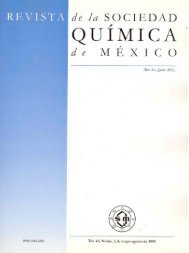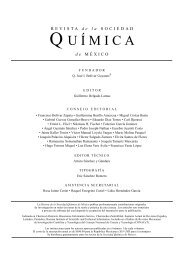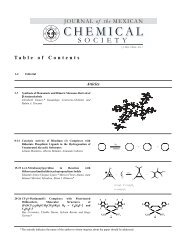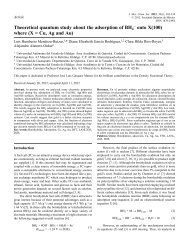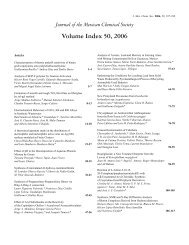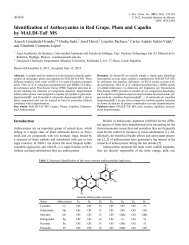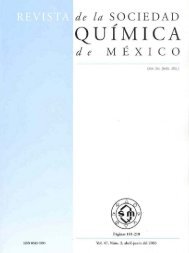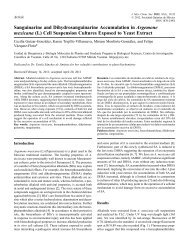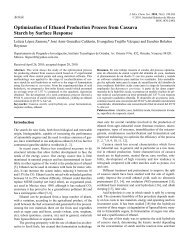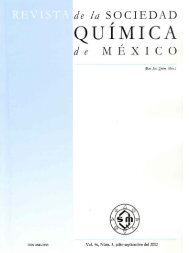SMQ-V043 N-001_ligas_size.pdf - Journal of the Mexican Chemical ...
SMQ-V043 N-001_ligas_size.pdf - Journal of the Mexican Chemical ...
SMQ-V043 N-001_ligas_size.pdf - Journal of the Mexican Chemical ...
Create successful ePaper yourself
Turn your PDF publications into a flip-book with our unique Google optimized e-Paper software.
26 Rev. Soc. Quím. Méx. Vol. 43, Núm. 1 (1999) V. Renugopalakrishnan et al.<br />
single phosphorylated Ser l6 residue. A comparison <strong>of</strong> <strong>the</strong><br />
amino acid sequence, i.e. <strong>the</strong> primary structure, <strong>of</strong> bovine<br />
amelogenin [5], with amelogenins from different species is<br />
shown in Fig. 2.<br />
Amelogenin structure function studies have been <strong>the</strong><br />
focus <strong>of</strong> research at our Harvard Laboratory since 1984 [6].<br />
Amelogein mutants and syn<strong>the</strong>tic fragments have potential<br />
clinical use in fighting Amelogenisis imperfecta (AI), a dental<br />
disease prevalent in Mexico.<br />
3. Commonly Occurring Secondary Structural<br />
Motifs in Proteins<br />
When <strong>the</strong> structural studies began in 1984, its primary structure<br />
was not known. Early structural studies <strong>of</strong> amelogenin<br />
were frustrating since <strong>the</strong> CD (Circular Dichroism) spectral<br />
features were not reminscent <strong>of</strong> proteins containing α-helical<br />
and/or β-sheet patterns [7]. The primary structure <strong>of</strong> calf<br />
amelogenin was derived by Edman degradation gas phase<br />
sequencing [5] and later from its cDNA sequence. The agreement<br />
between <strong>the</strong> two methods are excellent. Under normal<br />
circumstances, amelogenin would have been labelled a protein<br />
with a “random” structure e.g. lacking recognizable order. The<br />
intrepretation <strong>of</strong> its spectral features took an unexpected and<br />
surprising turn when its primary structure became availabIe<br />
[5] and it was found to contain unusual tandem repeats, especially<br />
starting from residues Gln 112 and extending upto Leu l38<br />
and <strong>the</strong> repetitive tandem template being a tripeptide<br />
sequence, (Gin-Pro-X) and such contiguous triplets occurred<br />
scattered throughout its primary structure. Amelognin is not<br />
<strong>the</strong> only protein in nature to contain such tandem repeats,<br />
albeit, <strong>the</strong> triplet template occurring nine times consecutively<br />
suggested that repeating polypeptide segment is probably<br />
composed <strong>of</strong> a helical array <strong>of</strong> repetitive β-turns, hairpin or U-<br />
turns wound around a common helical axis. Similar tandem<br />
repeats, have also been found to occur in elastin, RNA<br />
Polymerase II and it remains to be determined whe<strong>the</strong>r tandem<br />
repeats serve important structural and hence functional<br />
roles. The tandem repeats in elastin, [8, 9], have been ascribed<br />
a role in its elastomeric property, like in connective tissues in<br />
lungs, where <strong>the</strong> increase in volume during respiratory cycle<br />
requires a protein framework that can quite easily expand and<br />
contract while <strong>the</strong> tandem repeats in o<strong>the</strong>r proteins may have<br />
o<strong>the</strong>r important biological functions<br />
In <strong>the</strong> case <strong>of</strong> amelogenin, <strong>the</strong> major functional role is<br />
triggering Ca ++ ion accumulation in <strong>the</strong> process <strong>of</strong> building<br />
hydroxyapatite e.g. octacalcium phosphate crystals in enamel.<br />
The well organizad mineral associated with enamel has been<br />
strikingly demonstrated by recent atomic force microscopic<br />
studies <strong>of</strong> normal and Amelogenesis imperfecta afflicted<br />
human tooth enamel from our laboratories [10]. When one<br />
examines <strong>the</strong> amelogenin primary structure, it is ra<strong>the</strong>r surprising<br />
that such a primary structural entity will ever be implicated<br />
in a hydroxyapatite build up process on a bewildering<br />
time scale e.g. <strong>the</strong> entire process <strong>of</strong> mineral accumulation is<br />
complete in <strong>the</strong> very early phase <strong>of</strong> mammalian tooth development<br />
and amelogenin is rapidly degraded enzymatically after<br />
initiating mineralízation <strong>of</strong> enamel.<br />
4. Time-Resolved Picosecond Fluorescence<br />
Studies <strong>of</strong> Bovine Amelogenin<br />
We have inferred from <strong>the</strong> three different decay times, τ,<br />
observed from pico-second fluorescene spectroscopic studies<br />
<strong>of</strong> bovine amelogenin in solution [11], that ei<strong>the</strong>r amelogenin<br />
manifests three conformers equilibrating rapidly in aqueous<br />
solution or <strong>the</strong> three Trp residues present in its primary structure<br />
(Fig. 2) are on <strong>the</strong> surface <strong>of</strong> amelogenin, contributing to<br />
<strong>the</strong> three different decay times, τ.<br />
5. Circular Dichroism (CD) Spectroscopic<br />
Studies <strong>of</strong> Bovine Amelogenin<br />
Initial CD studies were indicative <strong>of</strong> a pattern similar to “random<br />
coil” proteins, [12] CD spectroscopy provides qualitative<br />
information on <strong>the</strong> secondary structure <strong>of</strong> a protein. CD bands<br />
arise from n – π and π – π* transitions in <strong>the</strong> electronic structure<br />
<strong>of</strong> a peptide moiety. CD spectral features <strong>of</strong> multiplet β-<br />
turn structures remain obscure even today. Fur<strong>the</strong>rmore, CD<br />
patterns <strong>of</strong> a β-sheet and β-turn protein with a large β-turn<br />
contribution are not available in <strong>the</strong> literature with <strong>the</strong> exception<br />
<strong>of</strong> tandem repeating segments in cereal storage proteins,<br />
tropoelastin, and RNAse polymerase II. The CD spectra <strong>of</strong><br />
mouse amelogenin, a 179 residue hydrophobic protein a<br />
recombinant manifests a temperature sensitive CD spectra in<br />
10 mM phosphate buffer which resembles <strong>the</strong> CD spectra <strong>of</strong><br />
tropoelastin polypeptides [11].<br />
6. Infrared Red (IR) and Raman Spectroscopic<br />
Studies <strong>of</strong> Bovine Amelogenin<br />
Neverthless, CD studies were contradicted by FT-IR studies<br />
[12], and laser Raman studies from our Harvard laboratory<br />
[13], which were suggestive <strong>of</strong> a β-turn and low β-sheet segments<br />
with a low α-helical content. Amide I mode usually<br />
occurs between 1600 and 1690 cm –1 and is largely C=O<br />
stretching frequency, amide II mode consists <strong>of</strong> C–N stretching<br />
and NH bending, occurring between 1480 and 1575 cm –1 ,<br />
and amide III mode, occurring between 1229 and 1301 cm –1 is<br />
similar to amide II mode. Amide II mode is sometimes, not<br />
always, absent in <strong>the</strong> Raman spectra <strong>of</strong> proteins. The amide I<br />
region <strong>of</strong> <strong>the</strong> FT-IR spectra <strong>of</strong> amelogenin as a function <strong>of</strong> pH<br />
[12] was subjected to Fourier self-deconvolution which<br />
revealed <strong>the</strong> sub-structures contributing to <strong>the</strong> broad amide I<br />
band. Fourier self-deconvolution <strong>of</strong> amide I band showed that<br />
<strong>the</strong> conformation features present in amelogenín were dominated<br />
by β-sheet and β-turn segments. Raman spectrum <strong>of</strong><br />
amelogenin in aqueous solution [l3] revealed a quadruplet




